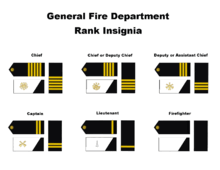Fire Service Ranks in the United States
In the United States , a firefighter's rank can usually be determined by the color of their helmet. White helmets stand for so-called “chief officers”, while red helmets stand for “company officers”. The individual design and color scheme varies from department to department. On the gala uniform, the most frequently used symbol for the rank is a fire or signal horn (called "bugle"), as it was used before the use of modern communication devices. The ranks go from Lieutenant (1 bugle) to Fire Chief (5 bugles).
The following levels exist in US fire departments, some of which are not used in every department:
- Firefighter - no bugles
- Engineer / Technician / Sergeant - no bugles
- Lieutenant - 1 bugle
- Captain - 2 bugles, either parallel (traditional) or crossed (less often)
- Battalion Chief - 2 bugles, either parallel (traditional) or crossed (less common)
- Division Chief / Deputy / Deputy Assistant or Chief / Commissioner - 3 crossed bugles
- Assistant Chief / Commissioner - 4 crossed bugles
- Chief / Commissioner - 5 crossed bugles
The smallest unit of the fire brigade is the so-called "company" under a lieutenant, who can therefore be compared to a group or platoon leader.
Some departments, such as the FDNY, use military rank insignia instead of the traditional bugles. The crossed fire fighting axes are rather rare as badges of rank.

